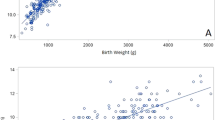Abstract
Objective
The purpose of the study is to compare conventional linear and fingertip ultrasound transducers, for the evaluation of umbilical catheters, with radiography. Fingertip ultrasound transducers have the potential to simplify sonographic examination due to their small size and ability to fit on a finger.
Study design
A prospective, IRB approved comparative study was performed. Linear and fingertip sonographic images were obtained around the same time as a radiograph in neonates with umbilical catheters by two board certified pediatric radiologists and a radiology resident. The positions of catheters were then compared across all three modalities.
Result
A total of 41 catheters were evaluated, which included 14 arterial and 27 venous catheters. Two venous catheters were not identified by the linear transducer and one arterial catheter tip was not identified by the fingertip transducer.
Conclusion
A fingertip ultrasound probe can be used to evaluate umbilical catheter positioning for potentially faster sonographic examination and decrease the need for repeated radiation.
This is a preview of subscription content, access via your institution
Access options
Subscribe to this journal
Receive 12 print issues and online access
$259.00 per year
only $21.58 per issue
Buy this article
- Purchase on Springer Link
- Instant access to full article PDF
Prices may be subject to local taxes which are calculated during checkout




Similar content being viewed by others
References
Diamond LK. Erythroblastosis foetalis or haemolytic disease of newborn. Proc R Soc Med. 1947;40:546–50.
Tsui BC, Richards GJ, Van, Aerde J. Umbilical vein catheterization under electrocardiogram guidance. Paediatr Anaesth. 2005;15:297–300.
Ades A, Sable C, Cummings S, Cross R, Markle B, Martin G. Echocardiographic evaluation of umbilical venous catheter placement. J Perinatol. 2003;23:24–8.
Pulickal AS, Charlagorla PK, Tume SC, Chhabra M, Narula P, Nadroo AM. Superiority of targeted neonatal echocardiograph for umbilical venous catheter tip localization: accuracy of a clinician performance model. J Perinatol. 2013;33:950–3.
George L, Waldman JD, Cohen ML, Segall ML, Kirkpatrick SE, Turner SW, et al. Umbilical vascular catheters: localization by two-dimensional echocardio/aortography. Pediatr Cardiol. 1982;2:237–43.
Oppenheimer DA, Caroll BA, Garth KE, Parker BR. Sonographic localization of neonatal umbilical catheters. Am J Roentgenol. 1982;138:1025–2032.
Fleming SE, Kim JH. Ultrasound-guided umbilical catheter insertion in neonates. J Perinatol. 2011;31:344–9.
Saul D, Ajayi S, Schutzman D, Horrow M. Sonongraphy for complete evaluation of neonatal intensive care unit central support devices: a pilot study. J Ultrasound Med. 2016;35:1564–1473.
Greenberg M, Movahed H, Peterson B, Bejar R. Placement of umbilical venous catheters with use of bedside real-time ultrasonography. J Pediatr. 1995;126:633–5.
Subramanian S, Moe DC, Vo JN. Ultrasound-guided tunneled lower extremity peripherally inserted central catheter placement in infants. JVIR. 2013;24:1910–3.
Harabor A, Soraisham A. Rates of intracardiac umbilical venous catheter placement in neonates. J Ultrasound Med. 2014;33:1557–61.
Meinen RD, Bauer AS, Devous K, et al. Point-of-care ultrasound use in umbilical line placement: a review. J Perinatol. 2020;40:560–6.
Franta J, Harabor A, Soraisham AS. Ultrasound assessment of umbilical venous catheter migration in preterm infants: a prospective study. Arch Dis Child Fetal Neonatal Ed. 2017;102:F251–5.
Benninger B, Corbett R, Delamarter T. Teaching a sonographically guided invasive procedure to first-year medical students using a novel finger transducer. J Ultrasound Med. 2013;32:659–66.
Acknowledgements
The views expressed in this abstract/manuscript are those of the author(s) and do not reflect the official policy or position of the Department of the Army, Department of Defense, or the US Government. The authors would like to thank Mr. Mike Lustik at the TAMC DCI for statistical support and assistance with the experimental design.
Funding
All direct funding came from Army Advanced Medical Technology Initiative AAMTI/TATRC. A grant totaling $160,000 from the Army Advanced Medical Technology Initiative (AAMTI) was awarded and used for research support. The company, Sonivate Medical who makes the SonicEye® devices donated the devices through a collaborative agreement. Sonivate Medical had no control over any part of the research protocol or what was reported in the manuscript.
Author information
Authors and Affiliations
Contributions
JRW maintained all research-related data and documents, wrote the majority of the article, obtained consents and performed multiple ultrasounds for the study, analyzed data. NRH contributed to protocol development, performed ultrasounds, gathered and collected data, maintained the data, revised article. KAB, Principal investigator, who wrote the AAMTI proposal, obtained the grant, help develop the protocol, obtained consents, and performed ultrasounds, revised article. CEC, Research coordinator, who assisted with obtaining and maintaining the grant, protocol development, coordinated IRB submission and approval process with study team, analyzed data, and helped write the article. PAW, NICU nurse, who maintained the equipment and ultrasound machines, helped obtain consents. EREK helped obtain consents and maintained data and documents for the study. VJR helped with protocol development, performed ultrasounds, helped analyze data, and revised the article.
Corresponding author
Ethics declarations
Conflict of interest
The authors declare that they have no conflict of interest.
Additional information
Publisher’s note Springer Nature remains neutral with regard to jurisdictional claims in published maps and institutional affiliations.
Rights and permissions
About this article
Cite this article
Wood, J.R., Halonen, N.R., Bear, K.A. et al. Fingertip ultrasound evaluation of umbilical catheter position in the neonatal intensive care unit compared to conventional ultrasound radiography: a preliminary investigation. J Perinatol 41, 1627–1632 (2021). https://doi.org/10.1038/s41372-020-00836-3
Received:
Revised:
Accepted:
Published:
Issue Date:
DOI: https://doi.org/10.1038/s41372-020-00836-3



